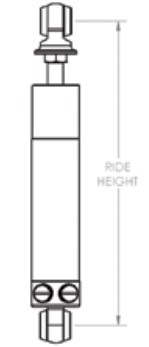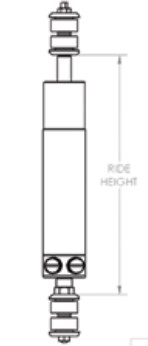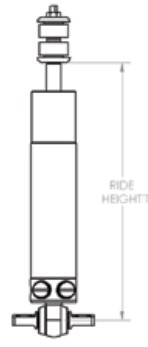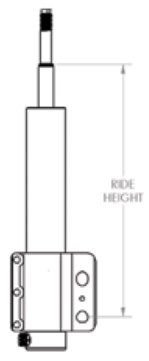When determining ride height, please make the measurements from the following points:
   
The ride height measurement for a shock / strut is absolutely critical. The shock/strut must have adequate travel in both compression and rebound.
Compression, also referred to as bump travel, is the dynamic movement where the suspension and wheel are pressed up into the chassis of the vehicle. It would be the first suspension movement direction when a wheel is hitting a bump. This also occurs during weight transfer events (such as cornering and acceleration/braking) on the specific vehicle corner(s) to which the weight is being transferred.
Rebound, also referred as droop travel or extension, is the dynamic movement where the suspension and wheel are moving away (extending) from the chassis. It would be the second suspension movement after the compression that occurs when hitting a bump, and it serves to move the vehicle back into a neutral suspension position (i.e. ride height). This also occurs during weight transfer events such as cornering and acceleration/braking. The decreased weight unloading off of the spring causes extension/rebound.
If the shock/strut is not within the appropriate range while the vehicle is at static ride height, the suspension will be improperly limited in travel in either direction, thereby not allowing for the shock/strut and spring to function as designed. This will result in horrible ride quality or poor performance results. If you install a new aftermarket shock/strut on your vehicle and you have the shock adjustments set properly but you are experiencing a harsh ride quality, it is extremely likely that the recommended ride height is not being adhered to. The often immediate, incorrect response is that the spring rate must be too stiff.
The first 3 steps in diagnosing a vehicle with harsh ride quality after installation of high quality aftermarket shock/struts:
Step 1: Check shock/strut adjustment settings
Step 2: Check ride height
Step 3: Go back to step 2 and double check the results
Another point worth mentioning is that even though you have a coil-over shock/strut, there is a limit to the adjustment, as the stance allowed is completely dependent on the shock/strut recommended ride height range. For example, we have had a situation where a person believes they need a stronger spring because they are trying to raise the vehicle by turning the spring nut and yet the vehicle is not going up. The ride height of the vehicle is not going up because the shock is topped out. When this occurs the spring nut will get very difficult to turn since every turn further compresses the spring. It is important to remember that unless the shock is bottomed out or topped out, the spring compression is not changing when you move the spring nut up or down. This is a very common misconception. As such, even if a heavier rate is installed, the same problem would occur since an increase to the spring rate will not change the fact that the shock is topped out. When determining the desired stance, the recommended shock ride height range must always be considered. That is why Viking has a standard height and a dropped height section in it's vehicle application guides due to the critical nature of getting the shock/strut length correct. Viking has done a lot of the homework for you under the “Search by Vehicle” product recommendations, as long as the stated assumptions are correct for your particular vehicle.
So how is this recommended shock ride height range determined? For a Viking shock/strut, it is determined by roughly 40% to 60% of the stroke. For example, a C213 is a 7” stroke shock: 40% of 7” is 2.80” and 60% of 7” is 4.20”. The C213 has a compressed height of 12.75” and an extended height 19.75”. Therefore, the recommended ride height is 15-1/2” (roughly 19.75” minus 4.20”) to 17” (roughly 19.75” minus 2.80”).
For general street driving, it is preferred to be more toward the higher range in order to have 60% of the stroke available for compression. This may not always be the case for a competitive set-up. For example, vehicles running certain leaf spring setups may want to see 3.5 to 4” of extension available. In that case, the preferred ride height would be the lower end of the range.
If you have a choice on the length of shock/strut, the general rule is the taller (more stroke), the better. That would allow for a larger recommended ride height range and more stroke for the valving to control the suspension. That sounds good in theory, but in reality certain vehicles do not have a large envelope available and/or a taller shock may cause issues at full droop, such as contact with the control arms/sway bars, unloading of the spring, etc. That is why shock valving becomes so important in order to control the suspension as needed within the stroke allowed for (see "Choosing the Valving").
The lesson is, do your homework and understand the desired ride height of your shocks/struts prior to making a purchase. This additional time spent will go a long way in assuring your desired goals are met for your vehicle.
|